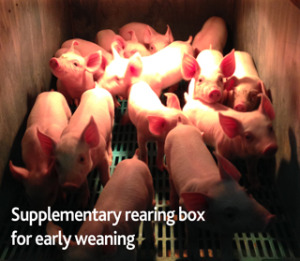As new technology advances and enables farmers to wean their best hyperprolific litters at 12 days old, is now the time to challenge and review legislative and farm assurance restrictions on early weaning that may have become outdated by recent advances in neonate technology?
Over more recent years as pig farming has advanced, so have some of our challenges. Consequently, a question my customers have asked me over the same period has changed. Instead of asking me how to increase their pig numbers, they are starting to ask me what to do with all these extra piglets! Litter size is increasing quite rapidly across the world and it’s become a challenge in some European countries – a nice challenge but still a challenge.
With so many piglets competing for a teat it is almost inevitable that preweaning mortality increases as litter size increases. To reduce the pressure and save as many piglets as possible the Danes use foster sows, the Germans use supplementary milk in the farrowing crate, the Dutch use Rescue Decks and the Brits use them all. They all work well as a means of supplementary rearing when used by skilled stockpersons but when stockmanship is compromised failures are seen. Some of my customers tell me that the most reliable systems are those that are easiest to use by removing some of those aspects which require more time and skill (e.g. preparing supplementary milk at the correct concentration and temperature).
Piglet support without the use of liquid milk
Supplementary rearing boxes using specialist dry pelleted diets (easily used by all staff whatever the skill level) are being more widely used to rear strong 12 day old litters and reduce litter sizes. Using these boxes ensures that less viable/smaller piglets are more able to compete on the sow. The boxes which are about half the size of an individual farrowing crate are used as the first step in a shunt foster. They are kept within existing farrowing accommodation and provide heat, high lactose pellets and water.
Other customers have deliberately reduced their sow herd size to maintain a constant number of pigs sold as their litter size increases. They rear the weaned 12 day old litter in the farrowing crate (spares exist now the herd size has fallen), adding a lamp, a small hopper and a water source to replicate the rearing box. This system is a little harsher than the rearing box and works best when a litter of big pigs is chosen and the sow is removed with her two smallest pigs to join the new 4 day old litter.
Rearing boxes. Here to stay?
We have seen these rearing boxes come and go in the past but I believe 2 things have changed that now make them more likely to be used more consistently. A new generation of neonate nutrition like Axcelera-P is now available and there are many more farms that have too many piglets. This approach is now easy to use, proven to work by saving more pigs and supports the productivity of pioneering pig producers.
Outdated legislation?
Concerns over the legislation which prevents routine weaning before 28 days of age is one factor weighing on the minds of the more progressive producers. Their dilemma is that they now have access to new technology that enables them to easily wean a few of their best 12 day old litters early, or do they just accept higher mortality across their excess pigs? Is now the time to challenge legislation that still reflects the pig husbandry of its time? Isn't there an argument for legislation to be updated to reflect advances in neonate technology that now make it possible for progressive farmers to safely rear more pigs in a more pioneering way?


